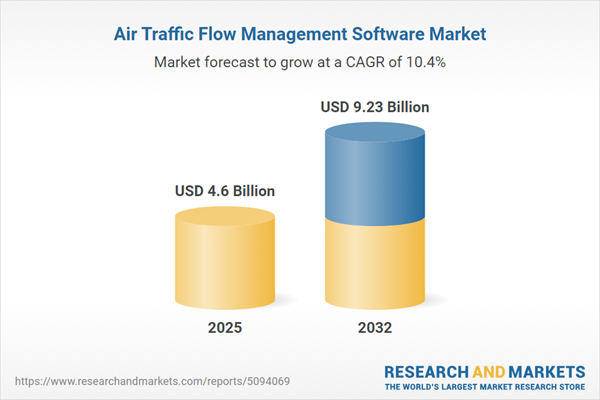Speak directly to the analyst to clarify any post sales queries you may have.
The air traffic flow management software market is rapidly evolving, with airlines, air navigation service providers, and defense sectors prioritizing digital innovation and operational optimization as regulatory requirements become more complex.
Market Snapshot: Air Traffic Flow Management Software Market
Sustained and robust growth defines the current state of the air traffic flow management software market, which is projected to achieve a strong double-digit compound annual growth rate (CAGR) over the coming years. The market’s expansion is driven by a surge in investments in digital transformation and the adoption of intelligent automation across civil and military airspaces. Predictive analytics offer enhanced compliance management and improved operational agility. As organizations increasingly seek scalable, resilient platforms, there is a decisive shift toward solutions that optimize resources, support seamless collaboration, and increase situational awareness. Adapting to evolving regulations, senior leaders are adopting advanced tools and infrastructure to promote efficient and integrated air traffic management.
Scope & Segmentation
This report offers essential insights for executives, strategic planners, and operational directors addressing complex air traffic management requirements. It focuses on critical market segments, deployment strategies, and solution developments that are influencing the global aviation sector.
- End User: Air Navigation Service Providers, Commercial Airlines, Ground Operations, and Defense sectors each use air traffic flow management software to enhance coordination, safety, responsiveness, and operational oversight.
- Solution Types: Capacity management platforms, collaborative decision-making tools, forecasting systems, and performance monitoring solutions address the broad demands of traffic control, resource utilization, communication, and regulatory transparency.
- Deployment Mode: Cloud-based solutions provide scalable infrastructure and secure remote access for organizations seeking flexibility, while on-premise deployments meet specific needs for regulation-driven, self-managed environments.
- Installation Type: New and greenfield integrations support expanded operational needs, while system upgrades and migrations help modernize legacy infrastructures, supporting consistency and digital preparedness.
- Geographic Regions: The Americas, Europe, Middle East and Africa, and Asia-Pacific each present distinct operational challenges, regulatory mandates, and solution customization drivers affecting technology adoption and compliance strategies.
- Key Companies: Lockheed Martin Corporation, Northrop Grumman Corporation, BAE Systems plc, Honeywell International Inc., Boeing Company, Leidos Holdings, Inc., NAVBLUE SAS, NEC Corporation, Unisys Corporation, and ADB SAFEGATE AB lead in technology progress and adoption of industry best practices.
Key Takeaways for Senior Decision-Makers
- Adopting cloud-native air traffic flow management solutions ensures smooth integration and simplified management processes for diverse aviation operations.
- Artificial intelligence and predictive analytics drive more accurate, timely decisions, helping organizations control complexity and strengthen airspace safety initiatives.
- Sustainability modules, such as emissions tracking, assist aviation stakeholders in monitoring environmental impact and aligning with evolving compliance targets.
- Unified data architectures foster efficient collaboration between civilian and military segments, supporting comprehensive governance and harmonized compliance efforts.
- Modular platforms allow rapid response to changing mission requirements and evolving regulations, promoting lasting operational agility.
- Diversified sourcing arrangements and regional partnerships provide greater resilience against regulatory change and geopolitical risk.
Tariff Impact: Effects of U.S. Trade Policies
U.S. tariffs affecting avionics components and software licenses have led to increased costs for aviation organizations. Many industry players now focus on sourcing solutions locally and utilize modular, cloud-based technologies to maintain financial agility and strengthen supply chain resilience as trade policies evolve.
Methodology & Data Sources
Findings in this report are based on a blend of validated secondary research, in-depth interviews with industry experts, and careful evaluation of supplier documentation. This approach ensures accuracy and delivers actionable insights for strategic decision-making in aviation.
Why This Report Matters
- Benchmark modernization and alignment projects, linking digital transformation efforts with stringent international air traffic management standards.
- Guide procurement and operations teams in evaluating risks and deploying advanced air traffic flow management technologies successfully.
- Clarify trends and regulatory shifts, enabling leaders to refine investment choices and pursue effective partnership strategies in air traffic management.
Conclusion
This report equips executives with the insights required to support modernization, foresee regulatory shifts, and guide strategic actions in air traffic flow management. It is an essential resource for forward-looking decision-makers.
Additional Product Information:
- Purchase of this report includes 1 year online access with quarterly updates.
- This report can be updated on request. Please contact our Customer Experience team using the Ask a Question widget on our website.
Table of Contents
3. Executive Summary
4. Market Overview
7. Cumulative Impact of Artificial Intelligence 2025
Companies Mentioned
The companies profiled in this Air Traffic Flow Management Software market report include:- Lockheed Martin Corporation
- Northrop Grumman Corporation
- BAE Systems plc
- Honeywell International Inc.
- Boeing Company
- Leidos Holdings, Inc.
- NAVBLUE SAS
- NEC Corporation
- Unisys Corporation
- ADB SAFEGATE AB
Table Information
| Report Attribute | Details |
|---|---|
| No. of Pages | 185 |
| Published | October 2025 |
| Forecast Period | 2025 - 2032 |
| Estimated Market Value ( USD | $ 4.6 Billion |
| Forecasted Market Value ( USD | $ 9.23 Billion |
| Compound Annual Growth Rate | 10.4% |
| Regions Covered | Global |
| No. of Companies Mentioned | 11 |









